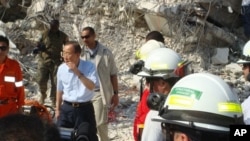U.N. Chief Ban Ki-moon has promised to expedite the massive humanitarian aid he says is needed to help Haitians stricken by last week's massive earthquake. The secretary-general visited the Haitian capital, Port-au-Prince, Sunday to assess the current relief effort and express his support to the Haitian people.
Mr. Ban's convoy traveled through several areas of Port-au-Prince Sunday, where broken buildings and shattered lives were on display.
Dozens of makeshift camps have been established in parks, school yards, anywhere there is an open space, to shelter those whose homes were demolished or are too structurally dangerous for them to return to.
The United Nations says one-in-three Haitians is in need of assistance following last Tuesday's massive quake, and another million are homeless. Mr. Ban told Haitians, help is arriving.
"For a small country like Haiti, this is a tsunami like disaster," Mr. Ban said. "This is a major catastrophe, and a huge humanitarian crisis, whose full dimensions we may not even know yet, particularly outside the capital. It requires a correspondingly massive response and help."
The death toll has been estimated in the tens of thousands, but there are also still scores of people missing.
The United Nations, which has some 12,000 personnel in Haiti as part of its stabilization mission, has confirmed the deaths of more than 40 staff. Among them, the chief of the mission and his deputy.
But on Sunday, there was a glimmer of hope that miracles can still happen.
An American search and rescue team working at the collapsed headquarters of the U.N. mission discovered Jens Kristensen, a civil affairs officer, buried in the rubble. They worked for hours to slowly shift the debris that trapped him, and at 2 p.m. (local time) he was pulled out alive.
The rescue happened just moments after Mr. Ban visited the site where most of the U.N. losses occurred. He spoke with rescuers and U.N. staff and then accepted the flag that had been flying at headquarters the day the quake struck. It will be displayed at U.N. headquarters in New York as a memorial to the fallen colleagues.
Search and rescue missions continue throughout Port-au-Prince. Some of the more than two dozen international teams that have arrived in Haiti could be seen working at sites of other collapsed buildings in search of survivors.
Mr. Ban assessed the physical breadth of the destruction from both the ground and air, using a helicopter to get an aerial view.
Journalists accompanying him also got a look at the widespread devastation.
Damage could be seen in neighborhoods with tightly packed houses and in slums along the hills of the capital. Some houses had collapsed with a domino-effect. Others had slightly toppled over to one side, while some had slid down hills. Many had collapsed on themselves.
At the city's Cathedral, only two partial walls remain. Nearby, the Presidential Palace is uninhabitable. Meanwhile, the Prime Minister's office is so damaged that neighbors have turned the garden into a camp.
Long gas lines could be seen at the few functioning stations and garbage was piling up across the city. Access to basic services is still severely limited and people are depending on food aid to survive. Concerns are growing that a frustrated, hungry and exhausted populace could turn violent.
On Monday, officials said the Secretary-General will ask the U.N. Security Council to temporarily authorize an additional 850 peacekeepers and 400 police for the Haiti mission, to assist with the humanitarian effort and deter instability.
As one U.N. official put it, "things were slowly improving here, and then the bottom dropped out of Haiti's world."
UN Chief Promises to Expedite Aid to Haiti Victims

Ban Ki-moon visited the Haitian capital, Port-au-Prince, Sunday to assess the current relief effort





